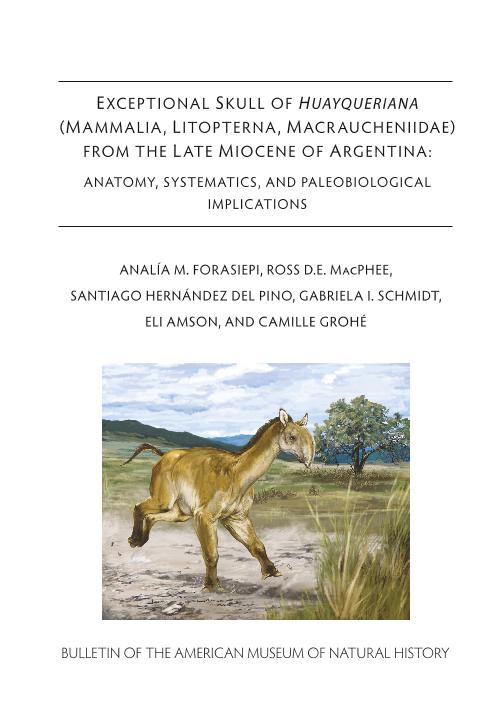Mostrar el registro sencillo del ítem
dc.contributor.author
Forasiepi, Analia Marta

dc.contributor.author
MacPhee, Ross D. E.
dc.contributor.author
Hernández del Pino, Santiago Ezequiel

dc.contributor.author
Schmidt, Gabriela Ines

dc.contributor.author
Amson, Eli
dc.contributor.author
Grohé, Camille
dc.date.available
2018-06-15T21:06:58Z
dc.date.issued
2016-06
dc.identifier.citation
Forasiepi, Analia Marta; MacPhee, Ross D. E.; Hernández del Pino, Santiago Ezequiel; Schmidt, Gabriela Ines; Amson, Eli; et al.; Exceptional skull of huayqueriana (mammalia, litopterna, macraucheniidae) from the late miocene of Argentina: Anatomy, systematics, and peleobiological implications; American Museum Natural History; Bulletin of the American Museum of Natural History; 404; 6-2016; 1-76
dc.identifier.issn
0003-0090
dc.identifier.uri
http://hdl.handle.net/11336/48885
dc.description.abstract
The Huayquerías Formation (Late Miocene, Huayquerian SALMA) is broadly exposed in westcentral Argentina (Mendoza). The target of several major paleontological expeditions in the first half of the 20th century, the Mendozan Huayquerías (badlands) have recently yielded a significant number of new fossil finds. In this contribution we describe a complete skull (IANIGLA-PV 29) and place it systematically as Huayqueriana cf. H. cristata (Rovereto, 1914) (Litopterna, Macraucheniidae). The specimen shares some nonexclusive features with H. cristata (similar size, rostral border of the orbit almost level with distal border of M3, convergence of maxillary bones at the level of the P3/P4 embrasure, flat snout, very protruding orbits, round outline of premaxillary area in palatal view, and small diastemata between I3/C and C/P1). Other differences (e.g., lack of sagittal crest) may or may not represent intraspecific variation. In addition to other features described here, endocast reconstruction utilizing computer tomography (CT) revealed the presence of a derived position of the orbitotemporal canal running below the rhinal fissure along the lateroventral aspect of the piriform lobe. CT scanning also established that the maxillary nerve (CN V2) leaves the skull through the sphenoorbital fissure, as in all other litopterns, a point previously contested for macraucheniids. The angle between the lateral semicircular canal and the plane of the base of the skull is about 26°, indicating that in life the head was oriented much as in modern horses. Depending on the variables used, estimates of the body mass of IANIGLA-PV 29 produced somewhat conflicting results. Our preferred body mass estimate is 250 kg, based on the centroid size of 36 3D cranial landmarks and accompanying low prediction error. The advanced degree of tooth wear in IANIGLA-PV 29 implies that the individual died well into old age. However, a count of cementum lines on the sectioned left M2 is consistent with an age at death of 10 or 11 years, younger than expected given its body mass. This suggests that the animal had a very abrasive diet. Phylogenetic analysis failed to resolve the position of IANIGLA-PV 29 satisfactorily, a result possibly influenced by intraspecific variation. There is no decisive evidence for the proposition that Huayqueriana, or any other litoptern, were foregut fermenters.
dc.format
application/pdf
dc.language.iso
eng
dc.publisher
American Museum Natural History

dc.rights
info:eu-repo/semantics/openAccess
dc.rights.uri
https://creativecommons.org/licenses/by-nc-sa/2.5/ar/
dc.subject
South American Native Ungulates
dc.subject
Litopterna
dc.subject
Macraucheniinae
dc.subject
Cenozoic
dc.subject.classification
Meteorología y Ciencias Atmosféricas

dc.subject.classification
Ciencias de la Tierra y relacionadas con el Medio Ambiente

dc.subject.classification
CIENCIAS NATURALES Y EXACTAS

dc.title
Exceptional skull of huayqueriana (mammalia, litopterna, macraucheniidae) from the late miocene of Argentina: Anatomy, systematics, and peleobiological implications
dc.type
info:eu-repo/semantics/article
dc.type
info:ar-repo/semantics/artículo
dc.type
info:eu-repo/semantics/publishedVersion
dc.date.updated
2018-05-28T14:49:21Z
dc.journal.volume
404
dc.journal.pagination
1-76
dc.journal.pais
Estados Unidos

dc.journal.ciudad
New York
dc.description.fil
Fil: Forasiepi, Analia Marta. Consejo Nacional de Investigaciones Científicas y Técnicas. Centro Científico Tecnológico Conicet - Mendoza. Instituto Argentino de Nivología, Glaciología y Ciencias Ambientales. Provincia de Mendoza. Instituto Argentino de Nivología, Glaciología y Ciencias Ambientales. Universidad Nacional de Cuyo. Instituto Argentino de Nivología, Glaciología y Ciencias Ambientales; Argentina
dc.description.fil
Fil: MacPhee, Ross D. E.. American Museum Of Natural History; Estados Unidos
dc.description.fil
Fil: Hernández del Pino, Santiago Ezequiel. Consejo Nacional de Investigaciones Científicas y Técnicas. Centro Científico Tecnológico Conicet - Mendoza. Instituto Argentino de Nivología, Glaciología y Ciencias Ambientales. Provincia de Mendoza. Instituto Argentino de Nivología, Glaciología y Ciencias Ambientales. Universidad Nacional de Cuyo. Instituto Argentino de Nivología, Glaciología y Ciencias Ambientales; Argentina
dc.description.fil
Fil: Schmidt, Gabriela Ines. Provincia de Entre Ríos. Centro de Investigaciones Científicas y Transferencia de Tecnología a la Producción. Universidad Autónoma de Entre Ríos. Centro de Investigaciones Científicas y Transferencia de Tecnología a la Producción. Consejo Nacional de Investigaciones Científicas y Técnicas. Centro Científico Tecnológico Conicet - Santa Fe. Centro de Investigaciones Científicas y Transferencia de Tecnología a la Producción; Argentina
dc.description.fil
Fil: Amson, Eli. Universitat Zurich; Suiza
dc.description.fil
Fil: Grohé, Camille. American Museum Of Natural History; Estados Unidos
dc.journal.title
Bulletin of the American Museum of Natural History

dc.relation.alternativeid
info:eu-repo/semantics/altIdentifier/url/http://digitallibrary.amnh.org/handle/2246/6659
Archivos asociados
